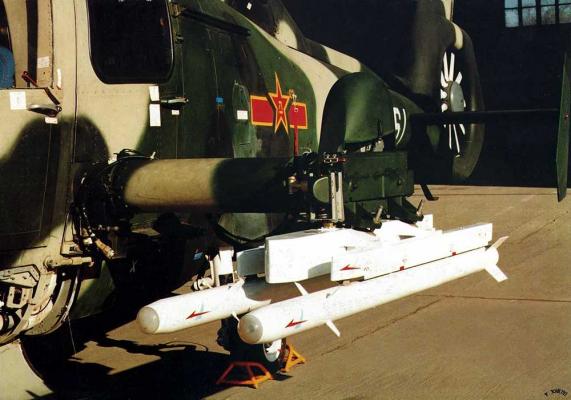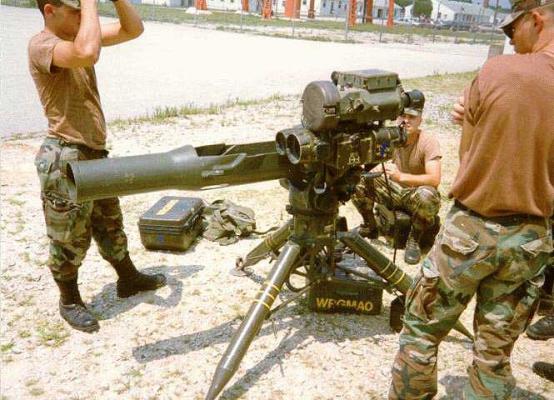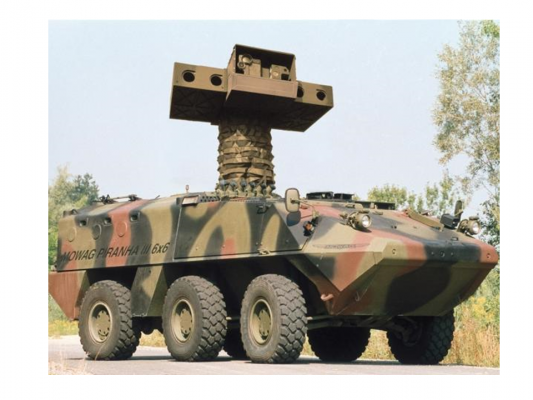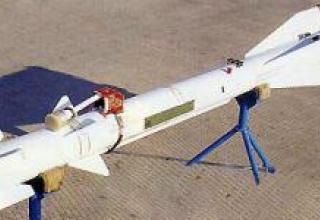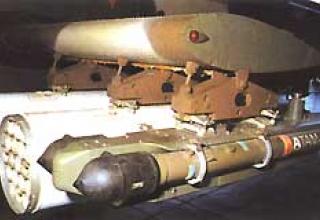TY-90 (Tian Yan - 'Celestial Swallow') missile of short-range air-to-air class is designed specifically for armament of combat helicopters and is designed to destroy helicopters, aircraft and enemy cruise missiles, including at low altitude.
TY-90 was developed by China National Aero-Technology Import & Export Corporation and first introduced in early 2000. The infrared homing head is developed by LOEC (Louyang optoelectro technology development center).
Despite some resemblance to the missile Chinese portable anti-aircraft system QW-2 missile TY-90 was originally created as a missile class "air-to-air", designed to arm helicopters. In contrast to the QW-2 missile is equipped with a combat unit of increased power, all-round thermal head of self-homing, a powerful marching engine, which provides a greater range, the possibility of hitting intensively maneuvering targets in the front and rear hemispheres. According to the developers, TY-90 can effectively fight modern helicopters such as AH-64, Mi-28, Ka-50/52, "Tiger", as well as attack aircraft Su-25, A-10 at low altitudes.
The missile is part of the armament of the new Chinese attack helicopter WZ-10. The two-seater WZ-10 carries 4 TY-90 each on wing consoles on both sides of the fuselage. Later on, options were developed for placement on Russian MI-17 helicopters, Chinese Z-9G, Z-11 and other carriers. In January 2008 at the Air Show in Zhuhai it was demonstrated the variant of TY-90 use as a part of the striking unmanned aerial vehicle armament (see photo). At present TY-90 missile is actively promoted at the international market by Chinese foreign trade corporation NORINCO (North Industries Corporation). However, as of the end of 2008, there are no data on export deliveries.
At IDEX 2009 (United Arab Emirates) NORINCO presented a new anti-aircraft missile system "Yitian", which uses the upgraded TY-90 missile as a means of destruction. It is reported about the works on using the missile in the composition of the ship "Type-730" and ground anti-aircraft missile-artillery complex LD-2000.
Composition:
TY-90 is made according to the scheme "duck" with non-folding aerodynamic surfaces (see photo). It is equipped with an all-around infrared homing head (HID). CNS (viewing angle ± 30°) is made on indium antimonide (InSb) and is equipped with a high-performance digital processor, which provides target selection against the background of the ground and when the enemy uses heat traps. The development and testing of the TY-90 version of the missile, which is equipped with a two-spectral CNS and a thermal imaging CNS with a sensor matrix placed in the focal plane of the optical system, has been reported.
The launch weight of the missile is about 20 kg. The firing range is from 500 m to 6 km, the altitude of the missile is from 15 m to 4 km and the maximum overload is 20g.
Battle unit (BC) - rod, weighing 3kg, optimized to defeat the carrier system of helicopters. The BC is equipped with contact and non-contact laser fuses and has an engagement radius of 4m. The calculated probability of hitting a typical target with one missile is 80%.
The TY-90 control system provides the launch of the missile both in the mode of gripping the GSN target in suspension under the carrier, and with the capture of the target on the trajectory. The primary target designation in the latter case is provided by the launch vehicle detection system or by the helmet-mounted target designation system (TMS). The NSTs of the WZ-10 helicopter were developed by the 613th research institute.
It is paired with the carrier board according to GJV289A standard (Chinese equivalent of MIL-STD-1553B).
Characteristics:
| Range of fire, m | 500-6000 |
| Battle ceilings, m | 6000 |
| Maximum flight speed, M | 2.2 |
| Dimensions, mm: - length - diameter |
1950 90 |
| Start weight, kg | 20 |
| Weight BC, kg | 3 |
| Defeat radius BC, m | 4 |
| Probability of hitting the target | 0.8 |
Testing:
The complex proved itself well in combat operations, in particular, a significant number of TOS-2 and TOS-2A missiles were used during the combat operations in the Persian Gulf area in 1991. According to the estimates of the foreign press, one of the Marine Corps units destroyed 93 armored targets, while using 120 vehicles.
The modernization of this complex is currently in progress. The works are aimed at further increasing the combat efficiency of the MANPAD, reducing its mass and dimensional characteristics and the amount of equipment included in its composition.
For example, a new ITAS launcher was developed on the instructions of the Ground Forces Command. Its main difference from the basic model is that all devices are combined into a compact unit, it uses a new combined sight, laser rangefinder and improved missile control equipment. Technical capabilities of the sight allow to engage targets in any visibility conditions at the maximum range of missile launch. In addition, it has advanced lifting and rotating mechanisms, as well as diagnostic and training equipment.
Raytheon has started to develop a missile capable of hitting targets on a "shot for forget" basis. It plans to develop a propulsion system using gel fuel, a more powerful BC, and a new thermal imaging homing head. At the same time, the missile should remain compatible with all TOW systems, including ITAS, and its launch range is expected to be at least 5 km.
Modernization of TOS complexes is carried out in other countries as well. In Denmark, for example, ETS (Elevated Tow System) has been successfully tested to verify that ETS can be launched from behind a shelter. This system is capable of engaging armoured fixed and moving targets at a range of up to 4 km with TOP missiles of all modifications. ETS is a tracked armored vehicle M113A1 with a stabilized platform rising to a height of 7 m, which combines into a single compact unit optronic system and PU for four missiles in the armored body. The platform is elevated to the required height for reconnaissance purposes and for launching PTUR by means of a hydraulic drive from a camping position.
The optical-electronic system includes a combined sight with optical and thermal channels with a tracking system, a laser rangefinder and a unit of the missile's flight control equipment. In addition, the advanced lifting and turning mechanisms of the PU ensure that the platform turns in two-speed mode. All incoming information is displayed on the displays of the commander and gunner-operator of the complex, located at workstations inside the APC. This complex is capable of carrying 20 missiles, four of which are in the AP platform. Recharge of missiles can be carried out in automatic and manual modes.
According to the developers, the installation of the platform with a lifting mechanism is also possible for other types of combat vehicles, in particular, the LAV series.

